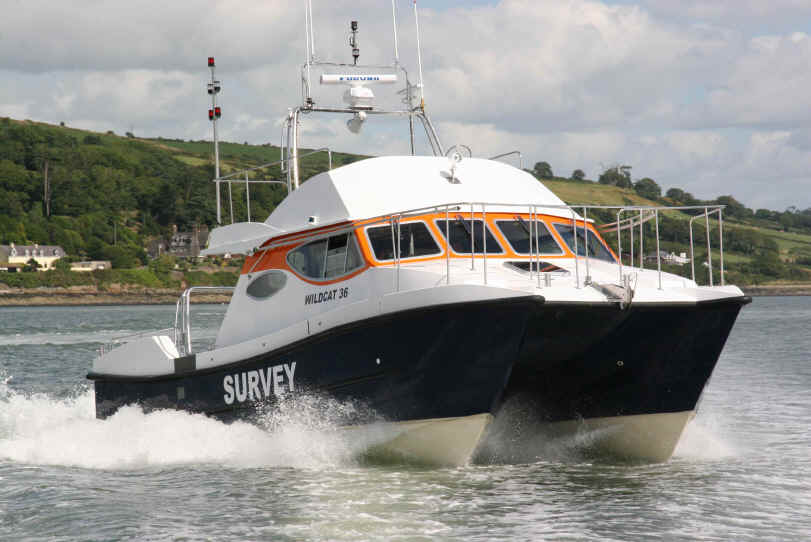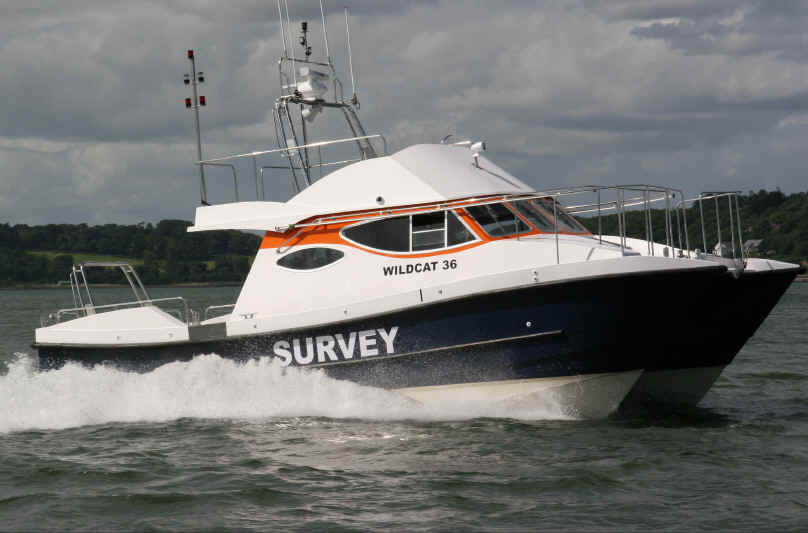

HOME MODEL RANGE CONTACT US GALLERY VIDEO DOWNLOAD PRICE LIST
SAFEHAVEN MARINE. Builders of the Interceptor & Wildcat range of offshore craft
'TEES NAVIGATOR' New survey vessel for Andrew Ridley, PD Teesport, Middlesbrough.
The ‘TEES NAVIGATOR’ is a dedicated survey vessel built for PD Teesport in Middlesbrough. Designed to deploy the new multi beam sonar equipment through a moon pool positioned between the hulls in the bridge deck. The sonar unit is lowered down through the moon pool to below the keel line for data acquisition at speeds up to 10kts.The expensive sonar head is very safely protected from damage by the two hulls. The sonar head is then raised up, the moon pool hatch closed and fast transit speeds of 20kts are achieved with the sonar head safely stored aboard. Her maximum speed is 23.6 kts on a 11,000kg displacment. 16kts comese up at only 1500rpm. She runs very smothly with zero vibration and low noise levels.



Below, the catamarans wide beam makes for a very spacious accommodation area
allowing a dedicated work bench for surveying equipment. A 1500rpm low rpm
generator provides 240v on board power. Air conditioning provides a comfortable
working environment.
Her helm console has been ergonomically designed to allow long fatigue free
periods at the helm, A car like driving position reduces back ache and is fully
adjustable.
A full galley is positioned in the port hull. A large berth is provided centrally over
the bridge deck. The heads compartment is situated in the st/bd hull.

Tees
Navigator is a Wildcat 36ft Catamaran built for PD Teesport, Middlesborough.
Andrew Ridley, the conservation manager of the port intended using the new multi
beam sonar head but was concerned with the vulnerability of the expensive sonar
head in conventional deployment practices currently used on Mono hull craft. He
opted to go the route of Catamaran, whereby the sonar head is deployed through a
moon pool in the bridge deck. The vessel was put to tender and was awarded to
Safehaven Marine and their Wildcat 36ft catamaran. Andrew chose the Wildcat
after a demonstration run in
The
vessel is based on the ‘Motor Yacht’ superstructure providing a large
accommodation area yet still maintaining a good working space in the aft
cockpit.
The
vessels general arrangement consists of a fully equipped galley in the port
hull, a berth positioned over the bridge deck. The heads and a second berth are
in the st/bd hull. The main cabin has a central twin seat helm position, and an
ergonomically designed helm position. On of the design criteria was to provide a
fatigue free driving position. To this end a special moulding was built allowing
the helmsman to sit upright in a car like driving position, avoiding the usual
‘hunched over the wheel’ back ache inducing helm positions.
Power
steering gives literally, ‘finger light’ steering with low revolution lock
to lock.
Survey
data acquisition is carried out from a large L shaped work bench with computer
racking provided below. Multiple 240v power outlets are provide below and
supplied by a low revving 1500rpm 6.5 kva Generator supplied by HFL. A 4 person
dinette is positioned to port and the Wildcats wide beam results in a very
spacious feeling to the whole craft.
Environment
comfort is maintained by a 3600BTU air conditioning unit providing a dry,
moisture free environment without ‘misting’ of the windows. H/D fendering
allows the craft to carry out light pilot duties, whilst the very high standard
of fit out allows VIP passenger duties as well.
The
vessel has been built with a moon pool positioned close the LCG in the bridge
deck. A large hatch is lifted and allows the sonar head to be deployed to below
the keel line allowing data acquisition to be carried out at speeds up to 10kts.
The valuable sonar head is fully protected by the twin hulls making it much less
vulnerable to damage than is the case when hung over the side or bow as is the
practice on mono hulls. The sonar head is then raised the moon pool hatch close
for fast transit speeds of 20kts.
Propulsion
is provided by twin Scania DI9’s at 318hp each. The Scanias were chosen for
the low revolution, long hr durability, aided by their unique piston ring
design, reducing carbon build up at low rpm which can be a problem on other
turbo engines running at prolonged low rpm. A long range is provided by 250
gallon capacity fuel tanks.
Other
features on the craft are dual helm positions, the second being from the crafts
flybridge. MOB recovery and deployment of additional data acquisition equipment
is provided by an ‘A’ frame positioned on the transom. Twin stainless steel
dive platforms give easy close access to the waterline. And finally the vessels
sleek and graceful lines make her very attractive on the water, discarding the
usual square and boxy lines found on small catamarans to produce one of the
nicest looking commercial catamarans available.